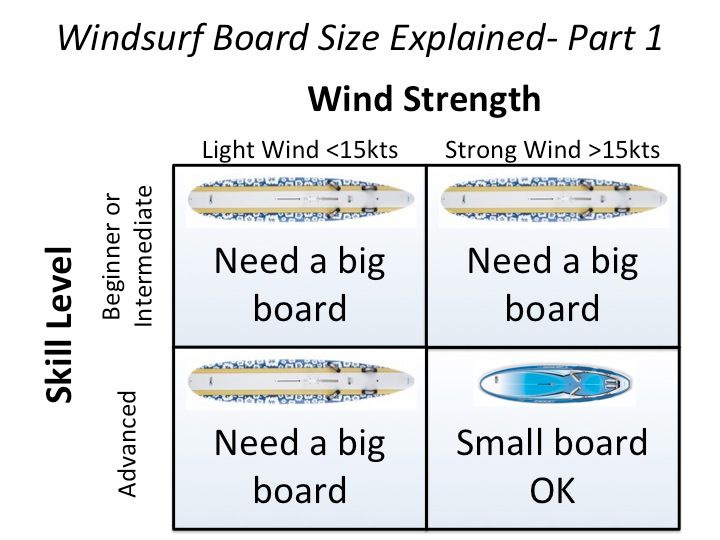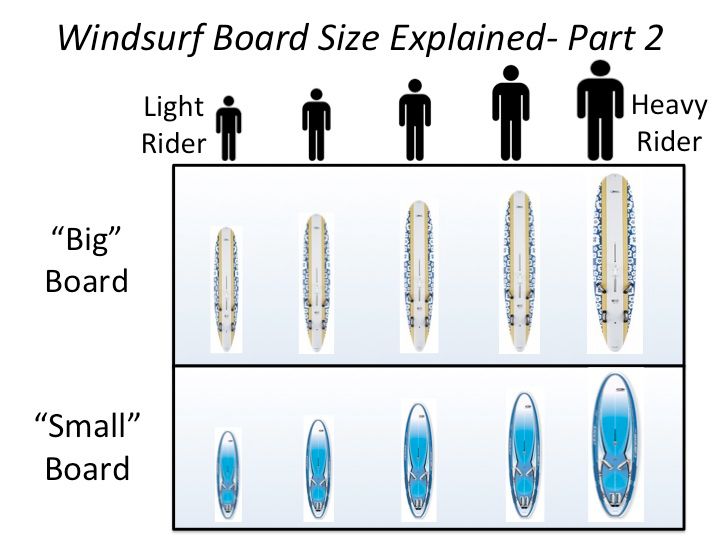Part of the reason it's tricky is because experienced windsurfers and the windsurfing media are a bad influence. We're always emphasizing progression to smaller boards, and dismissing big boards as just the "training wheels" of the sport. As a result, new windsurfers often end up with crazy misconceptions about what kind of gear to buy and what kind of path of progression to expect.
Here are some of the WORST pieces of advice that I typically hear:
Bad Advice #1- "I learned on XYZ terrible too-small board in the '80s, and now in PQR super-windy place where I live I never sail anything bigger than 85 liters, so if you're athletic and determined like me you should have no problem learning on this tiny shortboard that I want to sell you to use in your glassy calm 1-acre lake in Ohio."
Bad Advice #2- "Once you have a week or so of experience, you'll never again have use for a big longboard with a daggerboard, so you should just skip the longboard and buy this shortboard that doesn't work worth a crap unless the wind is blowing more than 15 knots."
Bad Advice #3- "If you want to learn to go fast and use the harness and footstraps and do jibes and waterstarts then you need to buy this tiny shortboard that will actually be impossible to sail unless you already know how to do all that stuff."
To counter some of that bad advice there is my Windsurfing Gear Calculator, which takes weight, wind strength, and skill level into account to figure out roughly what size and style of gear is appropriate. The calculator is a bit technical, though, so I've also tried to capture the essence of things in these two pictures:
This picture explains when you should use a big board, and when you should use a small board. Basically, small boards are only appropriate if you are a skilled windsurfer AND it's windy. When the wind is too light to plane, the best performing board will always be a big board with a daggerboard, and this is true regardless of the rider's skill.

This picture explains how board size is related to body size. What is a "big board" or a "small board" to you is relative to your body size, but the daggerboard also plays a role. I.e., a big person's small board would not be a good small person's big board, because it wouldn't have a daggerboard.


12 comments:
E-X-C-E-L-L-E-N-T! I get it! and, as a newbie, I have heard ALL of that bad (but well intended) advice. Long board (with dagger), here I come!
I was not aware they offer the K1 in several sizes :)
So, if a new surfer got a longboard, of sufficient volume, with dagger, that was new or not more than about ten years old, then he/she should be fine. The K1 has a cult like following, but it's not the highest rated even by folks like Jim D., but still, it would work just fine as would the Bic or Exocet or Mistral or Fanatic offerings for beginners. That's my conclusion on the matter after a lot of research. Thanks to the WS community et al for being so forthcoming. As Average Joe says, you can learn a lot without getting wet!
. . . and what the windward rail is to the experienced windsurfer, the uphill edge is to the skier. The daggerboard is a supplement to the windward rail (to reduce slip) that the experienced sailor does not need because he/she is able get in the straps, get on plane, hook in etc. and dig in; but, in light wind one cannot pull and dig into the windward rail hence Jim D's statement that "even experienced sailors need a daggerboard in light winds."
That sounds about right, Jon. To put it in terms of angles, think of straight into the wind as 0 degrees, and perpendicular to the wind as 90 degrees. In light wind with no daggerboard it's a struggle to attain even the modest 90 degree heading that you need to hold your ground. With more wind power you can edge with the windward rail and get maybe 70 degrees from the wind, which will let you hold your ground and slowly work your way upwind. With a daggerboard you can do a lot better, up to a max of about 45 degrees from the wind, which makes getting upwind much quicker. PS- There is one other way that windsurfers can go upwind without the daggerboard, but it only works when you're really blasting along, fully planing. It's called "riding the fin." Basically, instead of using the windward rail for bite, you keep the board flat or even tilted to leeward, and the tail fin provides all your lift and bite. It's tricky, but with the right setup, like a formula race board, a windsurfer riding the fin can get almost the same angle you'd get with a daggerboard, but with lots more forward speed. http://www.peterman.dk/windsurf-rail-bite-thomas-svendsen-520gb.htm
Well said.
Great post Mr. Douglas. Already referenced your first Figure in a response to a posting on Windsurf Canada. Great way to put it all in perspective. Gotta admit though, lots of people, me included, are solely in for that southeast quadrant of Fig 1.
If you don't live in Hawaii or the gorge you need a long board. I have an 1989 F2 race-board that is still fast in none planning conditions. The only problem I have with older boards is finding or making parts for them. Things like dagger board gasket, mast track car, new mast track pedals. The board itself is in great shape. I have recently purchased a Bic T293 which I like very much because of the parts problem.
I really enjoyed this post. I wrote an article on what the ideal board would be as a first purchase but this is nicely elaborated to emphasize that shortboards are not always the best option, even for experiences sailors.
At the surf center that I work at I sometimes have to insist they take a larger board because the wind conditions require them but they think it is taking a step backwards until they realize that up-hauling on 120 liters is not much fun.
Very spot-on post!
My friend looks awesome on a shortboard in perfect conditions in Bonaire.
The same guy looks really bad in more "real world" conditions on his shortboard, spending way too much time in the water hitting only about 10% of his jibes while
I'm on my Exocet 11'8 and having a blast taking full advantage of the day. To each his own but there's no question as to who is having more fun!
We all feel the stupid industry pressure of "once you get better you can graduate to a shortboard".
Sure, it's true for some lucky enough to live in an area that provides consistent suitable conditions or for those with the talent and experience but for most a big modern board is way more fun.
An added bonus with the longboard, you get that surfy feeling riding swell and waves even in light wind!
Love the comment about the 1 acre lake in Ohio. Our state parks have been working at making man made lakes and we now have lakes over 100 acres. How bout them apples. LOL
I did want to mention one thing about "old" longboards, there are items to bring the 80's into the 2000's. First, if your mast track uses a car, remove it and replace it with a mast track replacement nut. You can buy them at most windsurf shops. Second, and this was a game changer. I hated going barefoot on these old boards with no traction and 3 foot long mast tracks. I filled in the areas of the mast track I never use with foam and fiberglassed over top using a pinch of ding stick after all was said and done to cap off the inside, next I bought a SUP deck pad (get the ones already in sections, it's easier to work around the mast track and daggerboard openings). The old graphics that were left exposed were sanded away and new vinyl decals were applied to give the board a face lift. Now walking around in bare feet is comfy and plenty of grip. The deck pad was long enough it even allows me to get out on the nose for getting the fin out of the water for some oldschool freestyle moves. My Mistral Competition is done complete with blue tiki guys and habiscus flowers with a blue and gray deck pad. I'm reconditioning my old Bic Samba next for my daughter.
Super cool, Ottis! I'll bet having that deck pad is a huge improvement in user-friendliness for the old longboard.
Post a Comment